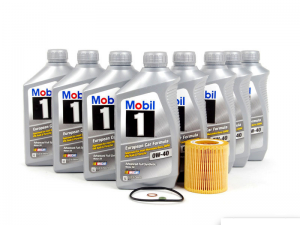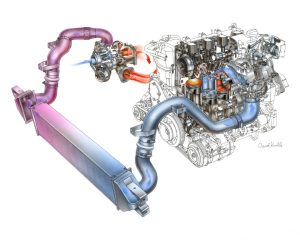Guest Post by Eric Peters

The fuel delivery system in a new car costs more than the entire engine used to.
And still does – if you’re lucky enough to own a V8-powered American car or truck built before the mid-1990s. If you do, you can usually buy a brand-new/manufacturer-warranted crate engine for about $2,000.
Compare that with the cost of a modern car engine’s direct-injection fuel delivery system – resorted to as a way to eke out another 2-3 MPGs vs. port fuel injection.
You don’t want to know . . .
It is my sincere desire to provide readers of this site with the best unbiased information available, and a forum where it can be discussed openly, as our Founders intended. But it is not easy nor inexpensive to do so, especially when those who wish to prevent us from making the truth known, attack us without mercy on all fronts on a daily basis. So each time you visit the site, I would ask that you consider the value that you receive and have received from The Burning Platform and the community of which you are a vital part. I can't do it all alone, and I need your help and support to keep it alive. Please consider contributing an amount commensurate to the value that you receive from this site and community, or even by becoming a sustaining supporter through periodic contributions. [Burning Platform LLC - PO Box 1520 Kulpsville, PA 19443] or Paypal
-----------------------------------------------------
To donate via Stripe, click here.
-----------------------------------------------------
Use promo code ILMF2, and save up to 66% on all MyPillow purchases. (The Burning Platform benefits when you use this promo code.)
If you ever have to replace the transmission in a car built since about 2010, better have smelling salts nearby. The tab for an eight/nine-ten-speed or “dual clutch” automatic – which the car companies have resorted to in order to eke out another 2-3 MPG vs. a four or five-speed overdrive transmission – can run as high as $5,000 – not counting the labor to install the beast.
If the air bags go off, the car is usually a total loss. Even if the car itself could easily be repaired. Because just replacing the driver and front seat passenger air bags can cost several thousand dollars – before a cent is spent to fix bent fenders. It’s easy to reach the financial threshold beyond which the car is not worth fixing.
These are just a few of the Costs of Uncle – the costs to us of the regulatory burden imposed by the government.
But there are other Cost of Uncle not as obvious.
One of these is the cost of changing a modern car’s oil. Because for openers there’s more oil to change.
I began to notice this during the course of doing the background research I always do prior to writing a review of a new car. A trend became apparent: New car engines may be smaller – but their oil capacities are greater.
This is particularly apparent when it comes to modern four cylinder engines – most of them in the 2 liter-ish range and turbocharged, to make up for their small size and (absent the turbo) insufficient power. Ford’s 2.3 liter “EcoBoost” four, as an example, has a capacity just under six quarts – about the same amount of oil required by the 7.4 liter V8 in my ’76 Pontiac Trans Am.
It costs as much to change the EcoBoost four’s oil as it does to change the oil in my old muscle car, which has an engine nearly three times as large.
Costs more, actually – because the Ford requires $10-plus per quart synthetic oil. Which it does because it’s turbocharged. Turbocharged engines run hotter and their internals are subjected to additional stress because they are literally pressurized. That is (cue Dr. Evil voice) what turbochargers do.
But turbochargers used to be rare.
They were generally added to increase the power of an already powerful engine. To make a sporty car sportier. The reason turbos are now as common as air bags is because they are being resorted to by the car companies to make up for power lost as the result of installing smaller engines in cars, including ordinary family cars.
Federal fuel economy fatwas have made V8s – and more recently, six-cylinder engines – as rare as ashtrays in new cars. You can still find them here and there, but they’re usually optional and not cheap.
Which is another Cost of Uncle.
V8s and V6s depress a car company’s Corporate Average Fuel Economy (CAFE) number.
The MPG difference between a six and a turbo four usually isn’t much – about 3-4 MPG overall is typical. It doesn’t seem like a lot – and it’s not, on a car vs. car basis. Hardly worth the fuss – or the cost.
But when scaled and factored over a car company’s entire yearly output – which is how CAFE averages are calculated – it does matter.
A great deal.
If the CAFE average dips too low, the “gas guzzler” fines appended become onerous; the company is at a competitive disadvantage vs. rivals whose cars aren’t saddled with exorbitant “gas guzzler” fines.
The only way to tilt the scale back in the government’s favor is to sell fewer cars (and other vehicles, such as trucks and SUVs) equipped with engines larger than four cylinders. The easiest way to do that is to make engines larger than four cylinders optional – and extra cost.
This has the side benefit of recovering some of the money that goes to pay the fines for failing to meet the CAFE average.
Paid for by the people who buy the cars, of course.
Never the fatwa-issuers.
The saying has it that there’s no such thing as a free lunch and that saying is even more true when it comes to the Cost of Uncle. People fall for it every time when a glib-gabbling, Tele-Prompter’d politician promises to wave his authoritarian wand and give them cars that get better gas mileage, are “safer” or some other boon.
But none of it comes free.
Uncle’s minions simply take the credit – and hand the bill to the marks who thought they were getting something for nothing.




I find nothing wrong with turbochargers.
Making smaller, lighter, more powerful engines that allow for more flexibility in vehicle designs seems like a worthwhile thing to me.
As for the oil, consider the extended oil change intervals into the cost equation.
I don’t have an opinion on the transmissions, really no experience with them to form one.
as an engineer for an auto manufacturer, I can give you some of the down sides.
Turbo’s have been around for decades, they are actually old technology. In the past , the
downsides prevented their use anything except Exotic “cost is no object ” sports cars.
-turbos generate higher under-hood temperature. this forced us to use more expensive materials on
many other under-hood components. Cooling system components must be up-sized to dissipate
additional heat. The cost increase in Other components is significant. This is also driving the
styling, the “gapeing mawl ” huge grill/radiator on the front of these vehicles is not a styling of
customer preference , it’s a thermodynamic necessity.
– the cost of the turbo and its associated cooling system is huge. these are super high precision
components. Materials for them are very expensive , again due to the temperatures they must
withstand. The parts count in theses systems also increase reliability concerns
So buy an inefficient low performance low efficiency heavy for its power clunker type engine if you consider them superior.
As for me, I prefer the power and efficiency of a light turbocharged small engine to a heavy, lower powered (weight to power ratio) and inefficient non turbo one. (lower weight for HP also puts less wear on suspensions, tires, brakes, etc.)
It’s your choice, both are available to you to suit your pleasure.
Maybe the very simple old Model T would be the best?
My 400hp hot rod gets 16 mpg if I dont drive like an asshole. My 67 chev p/u 4×4 gets 22mpg. Daily work beast. Easy to tune a carb to do that if you arent choking it with emissions horseshit.
The 69 chevy 2x pickup I used to own had a 6 cylinder engine and I averaged about 15 to 16 mpg, don’t have any idea how you got that mileage and I don’t know anyone else that has gotten that kind of mileage out of one of those.
FWIW, it was a business vehicle and I kept very accurate records of use and mileage for accounting purposes.
Cars handle better, have more power to weight ratio, and last longer than ever before.
Eric is a smart guy – but he has to find another shtick – not keep lamenting how cars ‘used to be’. As if all automobiles are to be compared to 1965. I guess in his mind 1965 (or there abouts) was the zenith of automotive engineering. I think not.
I don’t think the issue for Peters is ‘how cars used to be’ and I don’t think he’s opposed to new/better automotive development–the issue is how the government continually and increasingly mandates car makers to meet fuel economy or safety benchmarks. This has the effect of massively increasing costs and complexity while at the same time removing free market actions and choices. This sort of govt intervention happens practically across the entire spectrum of the market. And it costs us lots of dough
Bingo
Eric is correct about the massive increase in price of cars, in Dollars. Dollars have turned to crap since 1997, so the cost of a 3000 pound car might be similar in hours of median work.
Electric cars are too silent and should have growlers mandated for minimum audibility comparable to a V-8 with a failing water pump. That said, I really enjoy my 1995 Caprice 9C1 and 1983 MBZ 240D, both best-of-breed (with “safe weight” over 4000 pounds empty) and user-serviceable.
I didn’t enjoy the couple of years that included a car payment. 100% down is the best financing.
I love my 2015 Honda Accord EX-L Coupe with it’s 6 cylinder V-Tech engine. I may be loving this vehicle longer if Honda, as per this article pulls the V6 V-Tech from the lineup in 2018-2019. Oh to have my 1969 American Motors AMX with its wonderful 390ci V8 back! Who would have thought? Damn Bathhouse Barry and his minions.
I’ve replaced 2 turbos on cars, the bill was damn near $3k each. Modular components are my bitch, in each case a minor function of the part – but it’s all one big ass part. My other bitch is that NONE of this can be repaired locally anymore…..THAT is the big issue, and it’s that way on purpose. Same thing with big rigs, mechanics are part changers mostly.
I share the same gripe.
My way around it is owning a lathe, mill, welding equipment, and some other machine tools and electronics tools that allow me to repair almost anything and also make new parts from scratch sometimes when old ones aren’t really available.
FWIW, I repaired a emission control computer for less than 2 dollars (and that was at radio shack prices) by simply replacing two easily replaced electrolytic capacitors. The best price I could find on a “rebuilt” one was over 400 dollars for doing exactly the same repair.
There are a lot of repairable parts that get replaced by new or rebuilt ones now because the mechanic’s labor to fix them is expensive and mechanics aren’t taught how to do it because of that.
Remember when there were Chilton’s manuals?
In ’74 I bought a new Toyota. In the glove box, there was a mail-in card – you could get the shop manual for the car!
I used to go to the public library and copy the pages for the repair I was doing.
Fixing my car myself was how I coud afford to drive when I was a kid. My Dad made sure I was self reliant….or I had to walk.
I have often wondered what the results would be if you compared the increase in accidents caused by the blind spots created by the massive airbag-containing A-pillar in all new vehicles, with the lives those airbags save. I’d say its a wash at best.
Deaths per mile driven are declining from the pre airbag days. Much, much less likely to die or be seriously injured in an accident today than back in the 60’s, 70’s, and 80’s.
Or be stranded from breakdown. Or have a flat tire. Etc. Carsare vastly safer and more reliable thanones from the 60s or 70s.
That’s because cars in cities now average less than 18 miles per HOUR, rather than being useful tools to move things and get places. Their main function is to act as a tax vector , along with mortgaged housing.
I don’t doubt it, I was just talking about the blind spot created by A-pillar airbags.
Wonder how many pedestrians and bikers get hurt from those damn A pillars. When I’m a parking lot or backing out of a driveway, my head snaps around 10 times because I can barely see out the side of the car anymore.